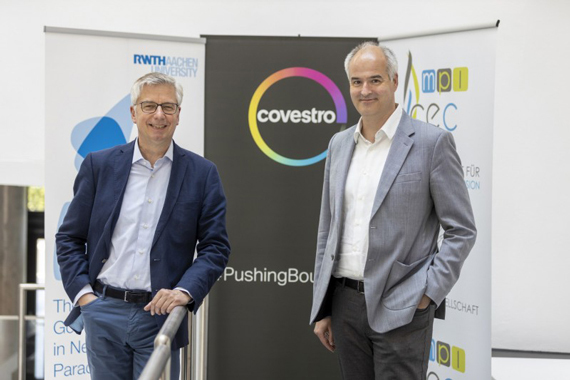More news

How can the climate gas carbon dioxide (CO2) be transformed into a valuable raw material, which in turn reduces the use of petroleum? With their role in the development of the CO2 technology, Christoph Gürtler, Head of Catalysis Research at Covestro, and Prof. Walter Leitner, Director at the Max Planck Institute for Chemical Energy Conversion as well as Professor at RWTH Aachen University are among the finalists for the European Inventor Award. The prize is conferred annually by the European Patent Office. The two chemists represent the team behind Covestro’s CO2 technology and were nominated in the industry category.
The CO2-technology makes it possible to use harmful carbon dioxide as a valuable raw material for sustainable plastics. The process uses chemical catalysts to drive reactions between CO2 and a conventional raw material. This process creates so-called polymers in a more sustainable and economically viable way. CO2 is tightly bound during the process.
Recognition "for the entire team"
"We are overwhelmed and enormously happy for the entire team, which collectively deserves this recognition. The participation in the inventor award for the CO2 technology is an important sign for all scientists, process engineers, application engineers and patent attorneys that years of research and development and professional patent management pay off – to create a more climate-friendly future in this case," says Christoph Gürtler.
"Our efforts to make chemistry more sustainable are once again bearing fruit. The fact that the contributions of basic research are being recognized as part of the development of such a process is an extraordinary recognition that would never have been possible without the interdisciplinary team behind it," adds Walter Leitner.
|
With its CO2-technology, Covestro has taken an important step toward the Circular Economy. Proportionally, up to 20 percent of fossil raw materials can now be replaced in products. The carbon from the CO2 then remains in the cycle without being released into the atmosphere. At the same time, initial studies suggest that this technology can also be used to produce more recyclable plastics, whose components could be more easily recycled. Markus Steilemann, CEO of Covestro, is convinced of the future-oriented technology: "We need to save fossil resources and make industry climate-neutral. With sustainable CO2-technology, we have set a leading light on the path to a circular economy. We are leaving the era of petroleum behind and driving the circular economy with alternative raw materials. I am proud of the team that has made this development possible." "To curb climate change, all sectors of society and the economy must reduce their carbon footprint. This cannot be done without far-reaching technical innovations, which in many areas require fundamental findings in chemistry. CO2 utilization, made possible by the team led by Walter Leitner and Christoph Gürtler, is an excellent example of this. And also of how fruitful cooperation between basic and applied research can be," says Martin Stratmann, President of the Max Planck Society. Joint solution from industry and scienceThe pioneering research and development work for the Inventor’s Award began in 2007 in joint BMBF-funded research projects ("Dream Reaction/ Dream Production"), which primarily involved Covestro and the CAT Catalytic Center as a joint research facility of Covestro and RWTH Aachen University, along with other partners. Once significant new findings on the effect of the catalyst were available, rapid further development of the innovative process became possible: an excellent example of the potential of partnerships between basic research and research-oriented industry. These developments were scaled up in other fields of application in two additional BMBF-funded projects („Dream Resource/ Dream Resource Conti") and form the basis for the CO2-technology of Covestro. CO2 generally only forms chemical compounds at great expense and only with the right partners under conditions optimized for this purpose. "The use of CO2 requires a ‘chemical matchmaker,’ so to speak: the catalyst," Leitner explains. It was this problem that the team had to solve. The combination of industrial and academic expertise, creativity, perseverance and many experiments finally culminated in success. The breakthrough was achieved by precisely controlling the reaction between CO2 and the petroleum-based alkylene oxide in the presence of a suitable catalyst system. "Working together, we found the right way to proceed, which can now be readily used for a large-scale chemical process," says Gürtler. The next step was taken in 2016: an industrial plant was installed in Dormagen, Germany. The reaction of CO2 with alkylene oxide produces so-called polyols. They are marketed by Covestro under the product name cardyon®. The polyols are already being used to produce soft foam for mattresses, for adhesives in sports flooring, padding in shoes and in car interiors. Elastic textile fibers are currently on the threshold of market maturity. Other Research projects have successfully demonstrated that CO2can also be deployed for insulating materials made of rigid foam and for surfactants, for example in detergents. |



